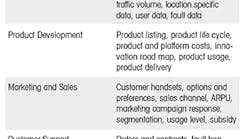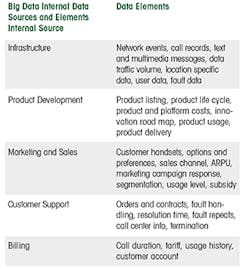Latest from Network Transformation/Edge Compute/IoT/URLLC/Automation/M2M
Why Harvest Your Big Data?
It Just Makes Cents
The telecom sector has always had access to Big Data with its massive volume of customer, operational and transactional data. Historically, the industry has used different technologies and techniques to understand it. Some include: statistical analysis, decision support, data mining, knowledge management, business intelligence, and business analytics. However, Big Data and Analytics (BDA) is unique in its potential impact on operational improvements, strategic decisions and even new revenue streams for the future. This makes BDA profoundly different from previous trends.
Why Big Data and Analytics in Telecom?
The telecom industry has a few pronounced business challenges, including:
• Demand for increasing customer personalization while keeping costs down.
• Need to optimize current processes to ensure that network planning allows for potential increase in revenue, going beyond a network-centric view.
• Need to maintain and increase revenue in the wake of increased competition and decline in traditional services.
Big Data can provide more than insights about an ICT company’s customer base. Some of the general areas where Big Data is typically used for improving business processes include:
• Analyzing network traffic in real-time to optimally route the traffic and improve service.
• Real-time monitoring of call data records by telecom operators and security agencies to reveal fraudulent behavior.
• Designing an optimal and flexible call plan instantly for customers, based on their usage patterns.
• Gaining insights into customer behavior and usage patterns, which in turn can help in developing new services and products.
• Leveraging data from social networks and online marketing initiatives by using intelligence from Big Data to gain better ROI on marketing and advertising campaigns.
An average telecom operator generates billions of records per day. In order to get the most from that data, it should be analyzed in real time or near real‐time. This is different from the traditional business intelligence (BI) methodologies that have been adopted by operators in the past. Older BI methodologies can take days and weeks for collection and analysis. Traditional BI is not as useful for situations where new customer applications demand action in minutes and hours.
RTBDA
Real‐Time Big Data Analytics (RTBDA) holds the key to unlocking great value in what is happening within ICT company’s networks. OTT companies such as Amazon and Google use it as the strategic foundation to make decisions in real‐time. RTBDA can produce results especially in the context of Internet content and the capabilities to record and analyze events on the network at any given moment.
Three particularly helpful sets of data are: customer data records (CDRs), Event Detail Records (EDRs), and IP Detail Records (IPDRs). This helps CSPs understand what is occurring in real‐time.
Additional Big Data sources for CSPs include phone calls, emails, messages, transactions, log data, social media usage/interactions, geo‐spatial information, external feeds, and data from sensors. These can be split into structured and unstructured data sources as shown in Figure 1.
Figure 1.
Big Data Challenges and Opportunities
Although telecom operators have the resources, skill, and willingness to take on Big Data projects, they can run into challenges. Developing and maintaining Big Data and Analytics applications is difficult, and some cannot afford the complexity it adds to business operations. That said, Big Data technology promises to derive new opportunities from these networks.
When starting down this road, carriers need to keep things as simple as possible. Rather than writing data to storage, they should stream data to analytics programs in real‐time (24-by-7). By doing this, operators can leverage data that resides in multiple systems, and help correlate that data to generate insight to drive their business forward.
In addition, CSPs are always looking at new revenue and business models. So while they should use Big Data for their own benefit, they should investigate selling data about mobile users’ locations, movements, and web‐browsing habits, to other companies. Though the privacy issues are tricky, this market is expected to grow into a multi-billion-dollar market by 2020. (See Source information at bottom of this article.)
This type of cross-selling is referred to as an asymmetric business model or two-sided market opportunity for telecom operators. This two-sided business delivery model draws from the larger trend of IT as a service, and it enables telecom service providers to create new revenue streams from their Big Data. This new megatrend has come about due to changes driven by market, regulatory, and economic aspects in the information and communications technology (ICT) industry. It is estimated that more than 60% of IT business will be part of the two-sided delivery model by 2020, with telecom service providers operating on both sides of this model.
(See Source information at bottom of this article.)
Source:
Mind Commerce Publishing’s research methodology encompasses input from a wide variety of sources. We believe that forecasts should be prepared as part of an integrated process, which involves both quantitative as well as qualitative factors.
The inputs are derived from industry players. Financial and other quantitative data for individual sub-market categories are derived from original research and tested with interviews with major industry constituents. For this research and forecasts, Mind Commerce Interviews of key decision makers and/or influencers:
Interviewed 3 major infrastructure providers
Interviewed 10 minor infrastructure suppliers
Interviewed 2 network integrators
Interviewed 8 global carriers
Save





